
by Deep Green Resistance News Service | Jun 9, 2018 | Obstruction & Occupation
by Agustin del Castillo, Milenio Jalisco / Intercontinental Cry
Wixaritari communities of San Sebastián Teponahuaxtlán (Wuaut + a), have detained first and second level government officials from Jalisco State in the town of Mesa del Tirador, in protest of the lack of answers to their demands—in particular, the issue of land restitution in Huajimic, in the neighboring state of Nayarit. The state government officially denies that the officials are being ‘forcibly’ detained.
Sources from the state executive and from the community, confirmed to MILENIO JALISCO that there are several secretaries who are being held after attending a meeting the community called with them to discuss and resolve various problems relating to education, health, road infrastructure and poverty. Officials have been warned by the communal leaders that as a means of pressuring the officials to resolve these issues—but above all, due to the federal government’s neglect of the issue of land restitution—they will remain in Mesa del Tirador.
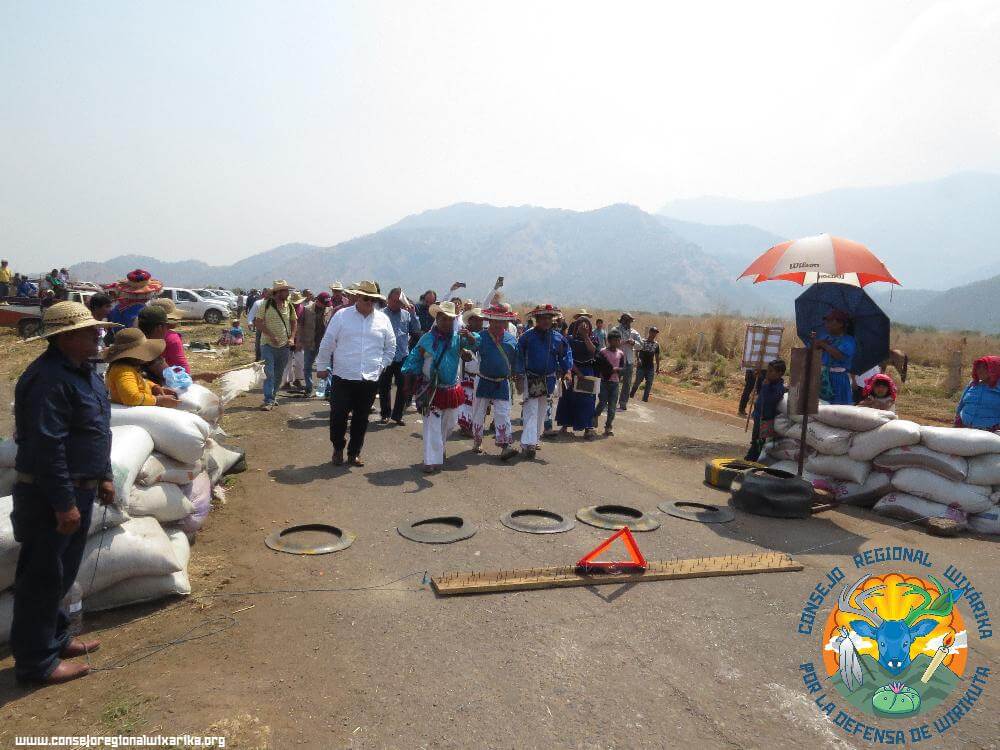
It was confirmed that the Secretary of Infrastructure and Public Works, Netzahualcóyotl Ornelas, is being detained at the meeting; as well as the Secretary of Education, Francisco Ayón López, and the Secretary of Development and Social Integration, Daviel Trujillo Cuevas; Lizana García, director of DIF Jalisco, and Mario Vladimir Avilés, director of agrarian affairs in the state; Mario Ramos Velasco, general director of the Secretariat of Rural Development (Seder); the municipal presidents of Bolaños, Juan Carlos Rodríguez Mayorga, and of Mezquitic, Misael de Haro.
Other retained officials include Andrés Palma Flores, delegate of the Ministry of the Interior; Rubén Ortega Lozano, director of the Human Rights Supervision Area, André Marx Miranda, director of CODE Jalisco; Ernesto Marroquín Álvarez, director of Support to Municipalities; Rogelio Azuara, delegate of the CDI Jalisco; Armando Pimentel Palomera, general director of Regions and Hospitals of the Ministry of Health.
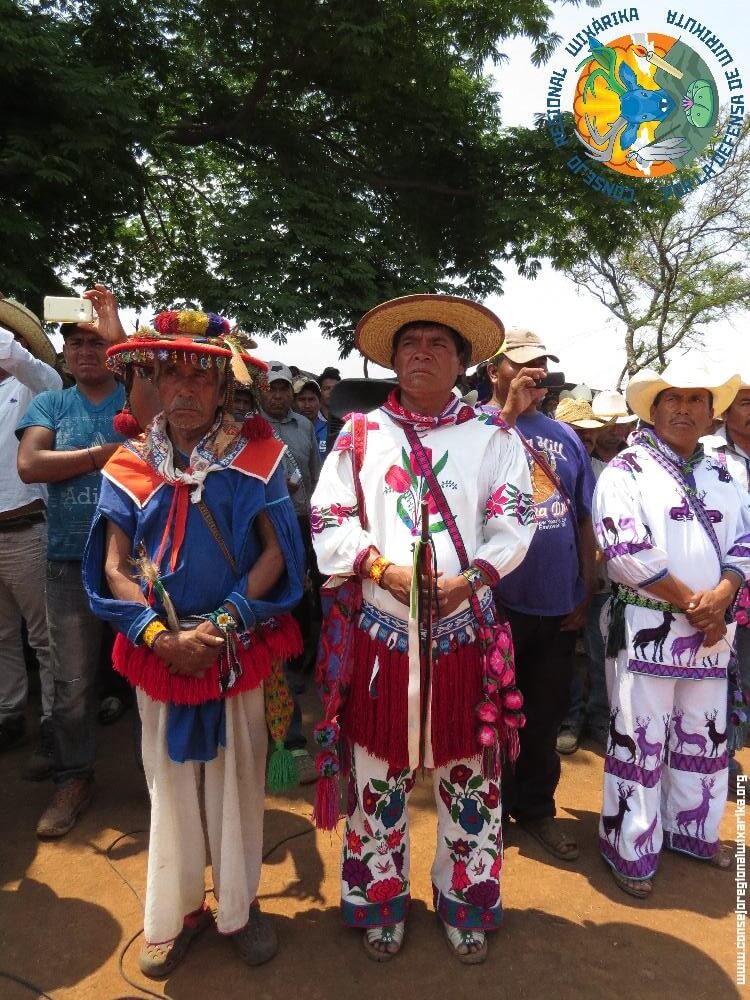
The demand is that the governor of the state, Aristóteles Sandoval Díaz, present himself to guarantee full compliance with all the lagged agreements.
“Mr. Vladimir stayed with us to advance the negotiations and bring us a proposal for a solution to the agrarian conflict, but he only informed us verbally, that he had met in Mexico and that the Ministry of Finance and Public Credit money to the Department of Agrarian, Territorial and Urban Development, to negotiate in ten days with the possessors, but just by word of mouth, did not deliver the promised agreement, did not give a check, and the assembly disagreed,” explained the spokesperson of the comuneros, Sofia Aukwe Mijarez.
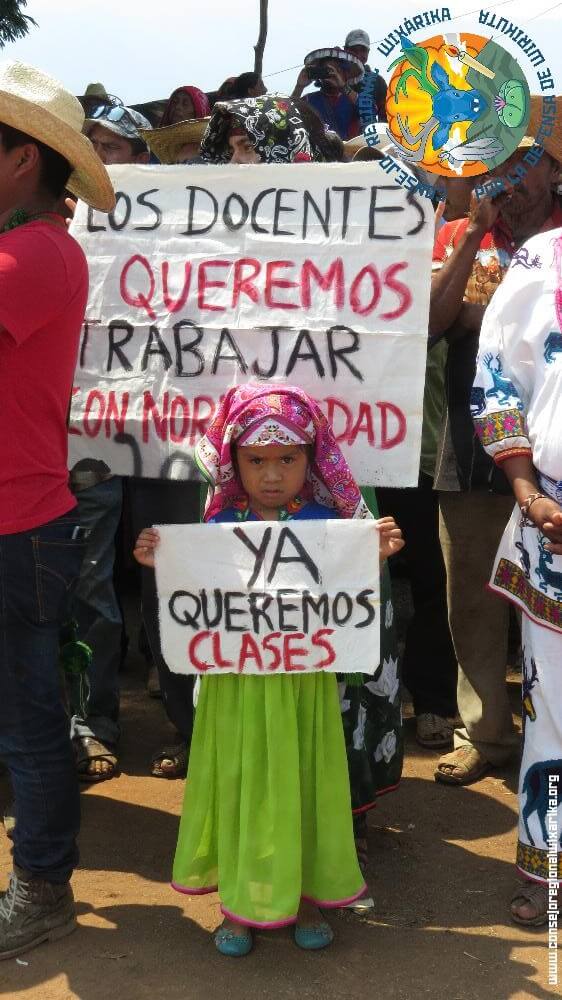
She clarified that there has been no threat or risk to the physical integrity of the officials, who remain working at work tables and that if the governor does not arrive at nightfall, “we have accommodation, food and blankets so that they are well protected.”
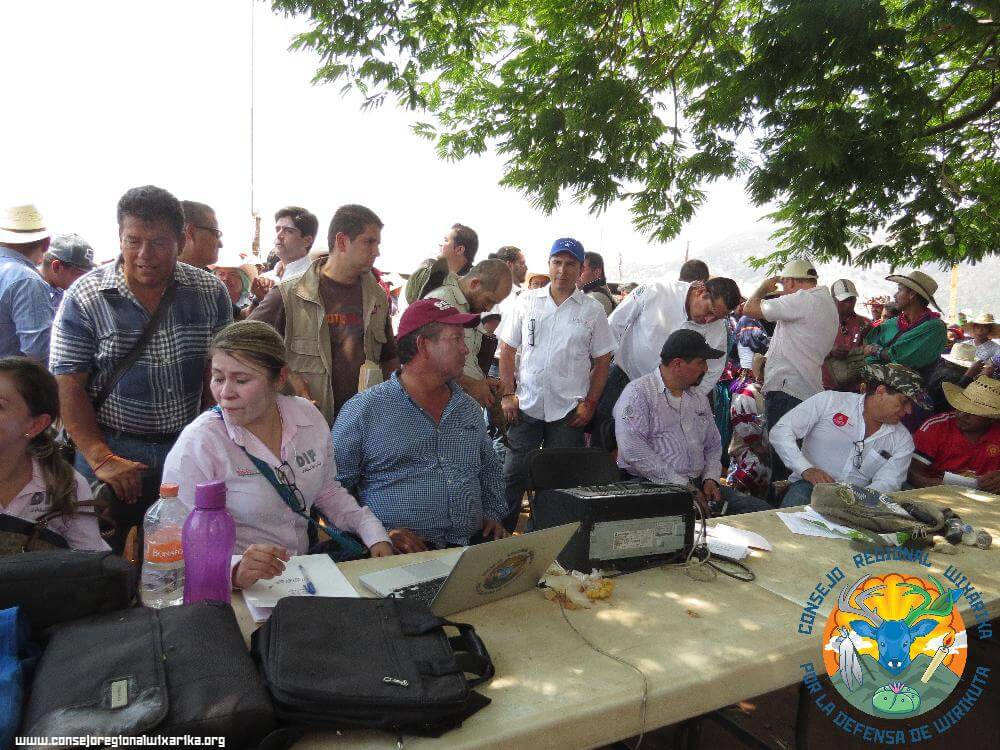
“DETENTION” DISMISSED BY STATE OFFICIALS
Interviewed by MILENIO JALISCO, the Secretary General of the State Government, Roberto López Lara, said that the officials are not being held against their will, and that they remain on the site because the work tables have not been concluded. The secretary acknowledges that there has been tension on some issues, but dismissed that state officials are forcibly detained.
López Lara explained that the points in which members of the Wixaritari community are dissatisfied are of federal order, especially due to the land dispute that exists between the indigenous people of the sierra, and community members of Nayarit, for which the state government acts as manager between the parties to expedite a solution to the conflict.
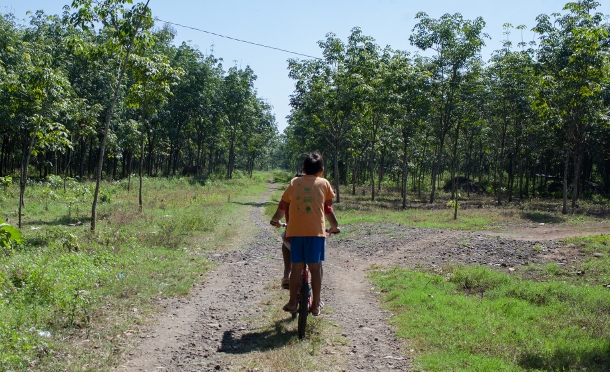
by Deep Green Resistance News Service | Jun 7, 2018 | NEWS, Reclamation & Expropriation
Featured image: Two children ride a bike through the plantation known as Las Palmeras in Guatemala. (WNV/Jeff Abbott)
by Jeff Abbott / Waging Nonviolence
Guatemala’s southern coast is in a constant conflict caused by the expansion of agro-industry. Across the region, small farmers struggle to feed their families as companies buy up more and more land for export crops.
Since the arrival of the Spanish to Guatemala in 1524, the country’s fertile southern coast has been the site of some of the most intense social conflicts over land. These conflicts have continued into the 21st century with the massive expansion of sugar cane and palm oil production.
Many of these land holdings have come to include illicit interests, including drug trafficking. But local small farmers, known as campesinos, have pushed back.
Since September 2016, 135 families associated with the Committee for Campesino Unity, also known by its Spanish acronym CUC, have maintained an occupation of a finca, or a large plantation, named Las Palmeras near the municipality of Cuyotenango. They are calling for the state to expropriate the land, which was once owned by a known drug trafficker, to the campesinos.
“We see the necessity [in our communities],” said Marcos (a pseudonym), a resident of the community of Progreso, who is supporting the occupation. “We have no place to work the land due to the amount of monoculture that surround us. They have made themselves the owners of the land. We have taken this finca because we need the land to sow the basic crops.”
The campesinos come from the surrounding departments of Quetzaltenango, Suchitepequez, and Retalhuleu.
The farmers have set up a small settlement on the finca, building small structures, as well as using the houses that are on the finca. They have established a collective store in the center of the finca, where they sell sodas, cooking oil and other common household items.
Since taking the finca, the campesinos have also begun to divide the land among the families. Many families have spent nearly two years sowing and harvesting several seasons of crops, including maize, beans, peanuts and fruits.
“They accuse us of land invasion,” said Francisco (a pseudonym), a campesino from a neighboring town who is supporting the occupation. “This is not an invasion, but rather a recuperation the lands of our ancestors.”
Organizing the occupations
Occupations have long been used in Guatemala by campesinos to gain titles to land. That practice grew dramatically in the 1950s following the passage of land reform under President Jacobo Arbenz. His administration expropriated unused land from large land holders, including the U.S.-based United Fruit Company, to be distributed among landless farmers across the country. After the U.S.-backed coup d’état in 1954, however, the tactic fell out of practice due to the threat of violence.
According to research by Charles D. Brockett, occupations would return to prominence in the late 1970s with the formation of the CUC. The organization was founded during the Guatemalan internal armed conflict and worked for the interests of the small farmers across Guatemala, as well as against structural inequalities and racism.
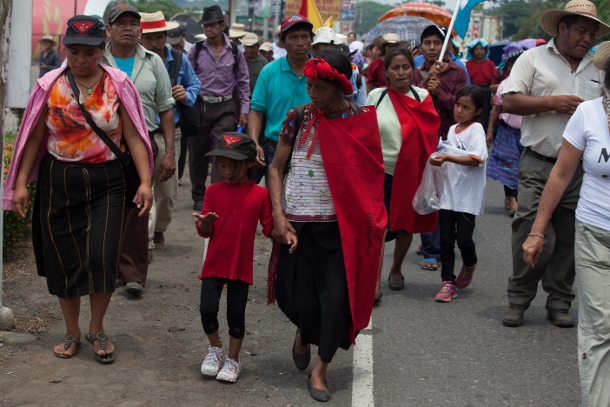
A woman wears a CUC flag while holding the hand of her daughter who wears a CUC hat during the 2016 water march. (WNV/Jeff Abbott)
Since the beginning of the 21st century, the region has seen the massive expansion of monocrops, such as sugar cane and bananas, for export by large landholders. This expansion of export crops further exacerbated the land crisis on the coast, driving many campesinos on the coast to organize to occupy the land due to the inequalities in land availability.
“The problem is that there is a lot of African palm oil, sugar cane, rubber and bananas being planted on the coast,” Marcos said. “These monocrops are leaving us without land to support our families. It was the necessity that drove us to take the finca. [The large land owners] have left us without any land.”
But the support from the CUC has been the key for the occupation on the Guatemalan coast, with the organization providing moral and legal support for the campesinos in Suchitepequez.
“After we launched the occupation, the CUC arrived to provide support,” Francisco said. “The CUC has worked for years to serve and support campesinos across Guatemala.”
The campesinos have also received support from other farmers who have participated in other occupations in the country. They sent others to support the occupation when it began.
“We had a meeting a few days [before the occupation] with other campesinos [that had participated in occupations],” Francisco said. “They saw the necessity of launching the occupation of the land. They decided on the date, where everyone came at 4 p.m. to occupy the land.”
Guatemala has a land problem that has dictated social relations from the Spanish invasion until today. A small percentage of the population controls the majority of arable lands that they utilize for the production of export crops for foreign markets such as sugar cane, African palm oil and bananas. This problem is being exacerbated by the rise of the influence of drug traffickers and criminal networks in the two decades since the end of the internal armed conflict in 1996.
Following the signing of the peace accords, the Guatemalan government established the Land Fund, which was meant to resolve the historic land problem. Yet the high price of the land often keeps it out of reach of landless farmers.
Narcos and land
Drug traffickers have increasingly taken to purchasing land as a means of laundering money, and as a means of transporting narcotics through Central America. As the country continues to work to fight drug trafficking in the country, campesinos have increasingly taken to occupying lands owned by convicted and accused drug traffickers, as well as lands owned by their associates.
The case of Finca Palmeras is a good example of this.
The finca was founded when the Ralda family purchased extensive land holdings in the department of Suchitepequez. Prior to the establishment of the finca, the land was largely used for rice production and cattle ranching.
When Manuel Ralda died, he divided the farm among his children, but his children chose to sell the land, including Finca Palmeras. In 1995, the lands of Finca Palmeras were transferred into the national land registry. Campesinos and others lined up to purchase the lands, but the price was outside the range made available by the Land Fund. The owners of the nine caballerias of land (or a little more than 850 acres) were set at 1.5 million quetzales per caballeria, or a little over 205,000 dollars.
“A group of campesinos entered that wanted to purchase the finca,” Francisco said. “But at the time, the Land Fund only provided credit for 1 million quetzales per caballeria. The fund would not provide the money to buy the land.”
Then entered Juan Alberto Ortiz Lopez — commonly known as Juan Chamale — who was one of the principal drug traffickers in Guatemala, and the main connection to the Mexican Sinaloa Cartel. He offered to buy the finca for 3 million quetzales per caballeria, and purchased the property. His goal was to create a front company to hide the transit of drugs from Colombia through the coastal region.
He quickly put in place security to block the local residents from passing through the finca to access the nearby Icán river, which was a popular fishing spot.
“Before we could fish in the rivers without any problem,” Francisco said. “But when Jaun Charmale bought the finca he put in place security guards, and it was prohibited to pass through the finca.”
According to the neighbors and campesinos occupying the finca, Charmale built new routes through the finca in order to move drugs. These routes connected to other fincas, eventually arriving at the Mexican border.
During the time that Ortiz Lopez owned the finca he would rent the lands to the neighboring fincas. This has caused problems for the campesinos occupying the land.
Furthermore, the campesino communities face an uphill battle to gain access to the land. The campesinos have faced intimidation and repression from the nearby fincas, including legal action over their occupation.
“We found ourselves with a problem,” Francisco said. “The neighboring fincas had sugar cane on part of the finca, and they filed a lawsuit against us in order to harvest that years’ crop.”
These lawsuits have included orders for the arrest of the organizers. The farmers also faced an eviction order that the police to date have not carried out.
Ortiz Lopez was finally arrested in 2011 on drug trafficking charges, and eventually extradited to the United States in 2014. At the time of his arrest, he was in possession of eight or nine fincas across Guatemala, which he would rent out to sugarcane producers, especially the nearby finca Palo Gordo. He had used the fincas as a means to launder his money from trafficking.
“The end of [Alvaro] Colom’s administration was when he finally fell,” Francisco said. “The government began to take the cattle that he had on the land.”
The campesinos are emboldened through the Law of Extinction of Domain, which was established in 2010. The law permits the expropriation of any assets of anyone convicted of a crime related to narco-trafficking, or any illicit crime.
Yet the campesinos’ claim is complicated. By the time he was arrested, Ortiz Lopez had put the titles for his land in his youngest son’s name. But campesinos from the region have laid claim to the lands, arguing that the Guatemalan government must apply the law, and expropriate the farm and distribute it among the small farmers.
Violence against occupying farmers
Despite the constant threat of eviction, the community has yet to see any violence. Meanwhile, other communities that have utilized the same law to argue for expropriating land have not been so lucky.
On October 30, 2017, the residents of the Q’eqchi’ Maya community of Chaab’il Ch’och were violently evicted from the homes they had occupied for a year. Police and military burned houses and crops, as well as the belongings of residents.
The community of Chaab’il Ch’och sits on a finca called Santa Isabel located in the municipality of Livingston, Ixabal. The finca was acquired by a shell company owned by former President Otto Pérez Molina.
The finca is currently being administered by Rodrigo Lainfiesta, a businessman and ally of Pérez Molina, who is also facing corruption charges. Pérez Molina is currently being prosecuted for corruption, as well as charges related to his association with drug traffickers.
In an interview for Upside Down World, one member of the occupation stated that they believed the land was used or going to be used for drug trafficking.
Yet, in spite of the violence against other communities, the campesinos in Suchitipequez are confident that they will emerge victorious.
“We are asking God that we will win, and believe we will,” Francisco said. “For our children, we do not want to see any more malnutrition in our communities.”
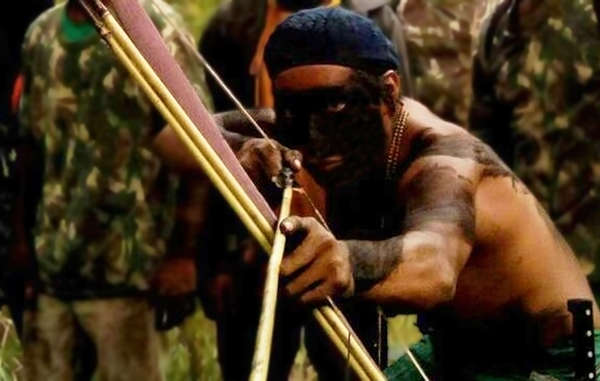
by Deep Green Resistance News Service | May 22, 2018 | Defensive Violence
Featured image: Guardians of the Amazon from the Guajajara tribe: “We patrol, we find the loggers, we destroy their equipment and we send them away. We’ve stopped many loggers. It’s working.” © Guardians of the Amazon
by Survival International
Members of an Amazon tribe patrolling their rainforest reserve to protect uncontacted relatives from illegal loggers have seized a notorious logging gang, burned their truck, and expelled them from the jungle.
The Guardians of the Amazon are from the Guajajara tribe: “We patrol, we find the loggers, we destroy their equipment and we send them away. We’ve stopped many loggers. It’s working.”
The area they are defending, Arariboia, is in the most threatened region in the entire Amazon. It is home to an uncontacted group of Awá Indians, a tribe well known for their affinity with animals and understanding of the forest, who face total annihilation if they come into contact with the loggers.
The Guardians have recently found abandoned Awá shelters close to where the loggers operate.
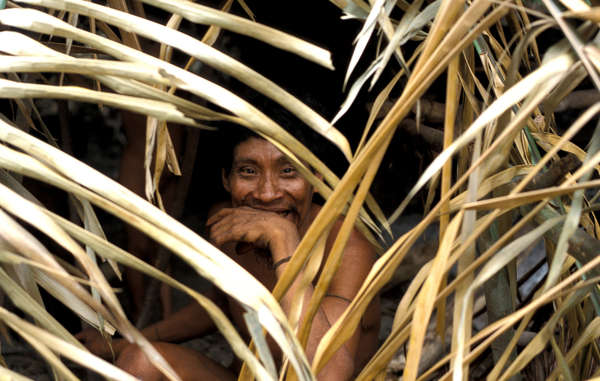
An Awá man called Takwarentxia, who was contacted in 1992 with his wife Hakõa’ĩ, and their baby. The rest of his family were killed by gunmen working for ranchers clearing the land. © Fiona Watson/Survival
They now fear violent retaliation. Three of the Guardians were murdered by loggers in 2016, and they have experienced arson attacks and regular death threats.
Burning Truck from Survival International on Vimeo.
The Guardians sent footage of the burning truck loaded with illegally cut timber to Survival International, along with the message: “Please show the world the reality we face. We know it’s risky and we have enemies but now’s no time for hiding. We want you to release this to the world so we can continue to protect our forest.”
Survival International has written urgently to the Brazilian government calling for the immediate and long term protection of both the Guardians themselves and of the area they fight to protect. Survival are also asking members of the public to send emails in support of the Guardians to government ministers via this page on their website.
Survival’s Director Stephen Corry said: “Tribal territories are the best barrier to deforestation, and these Guardians are defending the last patch of green amid a sea of destruction. It’s further proof that tribal peoples are the best conservationists and guardians of the natural world. The Guardians are virtually the only people standing between the loggers and the uncontacted Awá who still hold out in this forest. The Brazilian government’s inaction in the face of rampant illegal deforestation is shameful.”
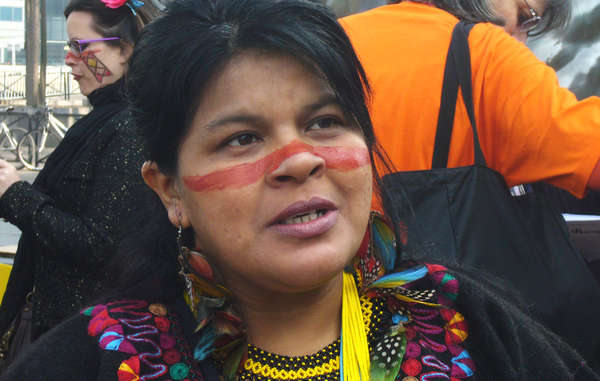
Sônia Guajajara at a protest in Paris against Brazil’s plans for a series of mega-dams in the Amazon, March 2014. © Survival International
She said today: “The Guardians’ work is both extremely valuable and incredibly risky. We indigenous peoples will never accept the ransacking of our Mother Earth – we listen to her and understand the way she talks to us because our life depends on her.”
BACKGROUND BRIEFING
The Guardians of the Amazon
– The “Guardians of the Amazon” are men from the Guajajara tribe in Brazil’s Maranhão state who have taken it upon themselves to protect what remains of this eastern edge of the Amazon rainforest.
– They want to save the land for the hundreds of Guajajara families who call it home, and their far less numerous neighbors: the uncontacted Awá Indians.
– The Guardians say of their work: “We patrol, we find the loggers, we destroy their equipment and we send them away. We’ve stopped many loggers. It’s working.”
– The Guardians recently released video and images of a rare encounter with the uncontacted Awá living in Arariboia. Watch the footage here
– You can see videos of several of the Guardians talking about their work on Survival’s Tribal Voice site.
Uncontacted tribes
– There are more than 100 uncontacted tribes worldwide. They have decided not to engage in regular contact with anyone from the outside world.
– They are not “lost” or trapped in a land that time forgot. They are aware of the outside world, and may engage sporadically with contacted tribes nearby.
– There’s irrefutable evidence that their tribal territories are the best barrier to deforestation, particularly in the Amazon rainforest.
– Uncontacted tribes are the most vulnerable peoples on the planet. Whole populations are wiped out by violence from outsiders who steal their land and resources, and by diseases like the flu and measles to which they have no resistance.
– It is not uncommon for 90% of the population to be wiped out following initial contact.
Awá
– The Awá are a hunter-gatherer people living in the forests of the eastern Brazilian Amazon
– While some Awá are in contact with the outside world, others are uncontacted.
– The Awá were known as “the most threatened tribe in the world” during a successful campaign by Survival International for the Brazilian government to expel the illegal loggers from one of their territories.
– The tribe are known for their affinity with the animals of their forest, and some families have more pets than people, from raccoon-like coatis to wild pigs and king vultures.
– Monkeys are the Awá’s favorites and individuals are often seen with their pet monkey riding on their head. Awá will rescue orphaned baby monkeys and adopt them as a member of the family, even breastfeeding them.
Arariboia
– The Arariboia indigenous territory comprises a unique biome in the transition area between the savannah and the Amazon rainforest.
– There are species here not found elsewhere in the Amazon.
– The land inside the indigenous territory is under threat from illegal loggers
– Brutal cuts in government funding to its indigenous affairs department FUNAI and tribal land protection mean the dangers are now even greater, as the area is not properly monitored or defended by the authorities.
– A powerful and violent logging mafia operates in the region, supported by some local politicians.
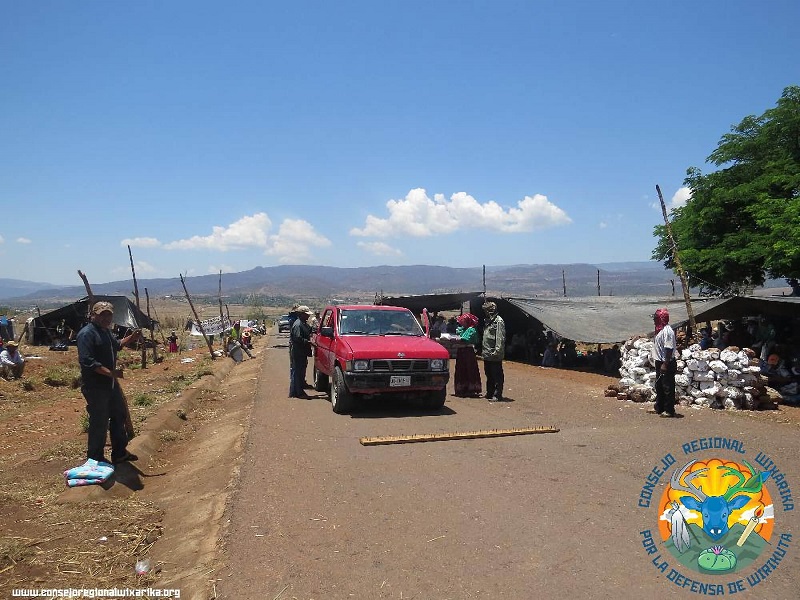
by Deep Green Resistance News Service | May 12, 2018 | Obstruction & Occupation
by Agustin del Castillo / Intercontinental Cry
Este artículo está disponible en español aquí
MESA DEL TIRADOR, Wixárika territories, Mexico — At midnight on May 10, 2018, members of the Wixárika (Huichol) community of Wuaut+a (San Sebastián Teponahuaxtlán), in the Western Sierra Madre of Mexico, took the dramatic step of blocking all entrances to their community, given the lack of response from the Mexican State for their demand to peacefully receive the lands that they have won from the ranchers of Huajimic in agrarian lawsuits.
Meeting in assembly in the Wixárika town of Mesa del Tirador, a few kilometers from the mestizo village of Puente de Camotlán, the communal and traditional authorities, together with the Regional Wixárika Council, declared in an official communiqué: “Today’s deadline for President C. Enrique Peña Nieto to appear before the community of Waut+a, was indicated in the Historical Statement made in Amolera on April 29 of the present year.
“In the control and surveillance post located in Mesa del Tirador, there is a group of 400 Wixaritari guarding the access in order to prevent passage by political operatives or others who have to do with the electoral processes; likewise we are seizing all electoral propaganda material.”
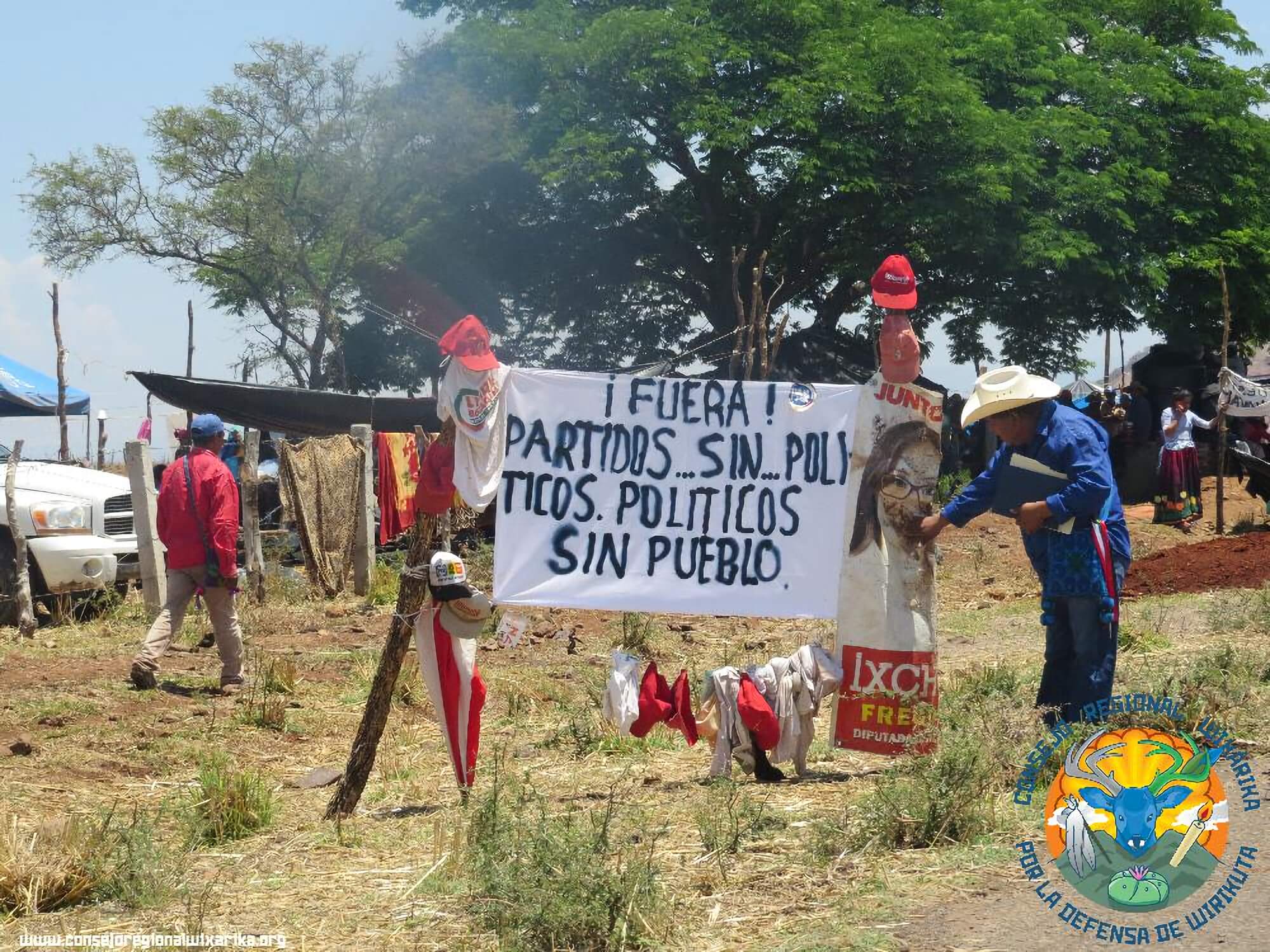
“Get out! Parties without politicians… Politicians without the People.” Mobilization in Mesa del Tirador expresses the frustration of Wixaritari with the political system. More than 7,000 Wixaritari from the community of Wuaut+a will not vote unless the situation regarding the return of ancestral lands from Huajimic is resolved. (Photo courtesy Wixárika Regional Council)
Three more roadblocks have been set up; one in Cerro de la Puerta, one in Las Cañadas (Banderitas or El Miguelón), and a third in El Pacheco. “The demand of the Wixárika community is a solution to the agrarian and border disputes between the states of Nayarit and Jalisco. The community demands that the President of the Republic present himself at the point where the state limits are located, at the limits of the two different worlds, If he fails to show up by the stated deadline, at 11:59 pm, the four surveillance posts will close the two roads to the general public: the Tepic-Aguascalientes highway (Mesa del Tirador-Las Cañadas), and the Carretera Huejuquilla – Amatitán (Cerro de la Puerta and El Pacheco). There will also be 35 schools closed, from preschool, primary and secondary, until the executive presents himself in the community of Waut+a; otherwise, will not vote on July 1 of 2018.”
The deadline passed without any government response, and the Wixárika closed the roads and the schools as promised. More than 7,000 Wixaritari from the community of Wuaut+a will refuse to vote, and they will block installation of the voting booths in the community.
“We are not going to give more votes to the political system we have in Mexico. I believe that all Mexicans no longer feel represented; we have a failed state, we have the absence of the rule of law and I think that it is not only the Wixaritari, who are suffering these legal failures in the Mexican State,” said Ubaldo Valdez, commissioned spokesman for the Surveillance Committee of Mesa del Tirador, Bolaños.
Despite the presidential absence, yesterday a meeting was held in Mexico City among representatives of the Ministry of the Interior, the Secretariat of Agrarian, Territorial and Urban Development, and the Secretaries of the Government of Jalisco and Nayarit (see below). They requested three days of extension for the community members for the next step of the protest, but the community assembly refused.
The consequences of a total closure to the circulation of the roads will have a significant economic impact, since they comprise the commercial routes between the Sierra of Nayarit and the Zacatecan highlands, and between the Bolaños canyon towns and the northernmost zone of Jalisco, Huejuquilla and Mezquitic.
“Many are looking at the the possibility that the community provide its own supplies, but it sounds complex because there are 36 main localities and it is a very vast territory and badly connected,” said one observer of the meeting.
The precedent of this dramatic measure was the action taken by the residents of Tuapurie, or Santa Catarina, another of the principal Wixárika communities, who closed the schools of the community for more than a month and blocked roads, until they were visited by the governor of the state, Aristóteles Sandoval, on October 31, 2017. In that case, there are demands for basic services, such as health and education, which are also part of the demands of Wuaut+a, whose central component is the return of their ancestral lands in Huajimic.
For the background on this ongoing land recovery struggle for the restitution of 10,000 hectares of ancestral Wixárika lands, see IC’s previous coverage on the issue.
Agreements in Mexico City
Representatives from the Ministry of the Interior (Segob), the Secretariat of Agrarian, Territorial and Urban Development (Sedatu), the National Commission for the Development of Indigenous Peoples, the Ministry of Finance and Public Credit and the Secretariats of the Government of Jalisco and Nayarit, met Wednesday in the capital of the country to determine the solution to the Gordian knot of the compensation to Huajimic landholders, the losers of the agrarian lawsuits in favor of the indigenous community of Wuaut+a.
Aldo Saúl Muñoz López, magistrate of the executing court, Agrarian Tribunal 56 of Tepic, told MILENIO JALISCO that during the past few days he had asked for reports of the files, but had not received until Wednesday night the expected call about the final route of money to defuse the conflict in the Sierra.
For his part, Roberto López Lara, secretary of the Government of Jalisco, published in his Twitter account: “In the case of the community of San Sebastián Teponahuaxtlán, a working group was set up where @SEGOB_mx, @ SEDATU_mx, @SHCP_mx and the states of Jalisco and Nayarit participated to follow up on the trial carried out by residents of this area.”
At the same time, the conflict in San Andrés Cohamiata, another northern neighbor of Wuaut+a, was addressed. The community has been threatened with territorial division to favor mining interests protected by Nayarit. “… between the @GobiernoJalisco and @NayaritGobierno, we recognized through an agreement, the integrity of the territory, the uses and customs of the Wixárika community of San Andrés Cohamiata”.
The next judicial executions in favor of Wuaut+a are scheduled by Agrarian Tribunal 56 for May 23 and 30, 2018.
by Deep Green Resistance News Service | Apr 29, 2018 | Property & Material Destruction
Editor’s note: this is an anonymous communiqué previously published on Philly Anti-Capitalist. The featured image is unrelated to this action.
Early last week, we made the two tractors that Energy Transfer Partners was using to construct the Mariner East 2 pipeline near Exton, PA inoperative by cutting their hoses and electrical wires, cutting off valve stems to deflate the tires, introducing sand into their systems, putting potatoes in the exhaust pipes, using contact cement to close off the machines’ panels and fuel tanks, and a variety of other mischievous improvised sabotage techniques.
We feel called to fight for the natural world and would be lazy to submit to the demise of the earth, animal and self by not fighting against its destruction by machines and corporations who seek to kill it for capitalist growth. It was surprisingly easy and brought us so much joy. We’ve read since that ETP has had to acknowledge the damage, which they are usually careful to cover up, and see that this wreck of a project could be seriously compromised by the proliferation of more actions like these.
For those restless, angry warriors out there, we hope you find similar happiness in destroying little by little the tools of this capitalist settler-colonial nation. Death to colonization and capitalism… Shout out to everyone out there still attacking in spite of repression and grief.
by Deep Green Resistance News Service | Apr 12, 2018 | Obstruction & Occupation
by Zad Forever
We are writing with the smell of tear gas rising from our fingers. The springtime symphony of birdsong is punctuated by the explosive echo of concussion grenades. Our eyes are watering, less from the gas than the sadness; because our friends’ homes, barns and organic farms are being destroyed. Bulldozers, supported by 2500 riot police, armored vehicles, helicopters and drones, are rampaging through these forests, pastures and wetlands to crush the future we are building here on the to the zad (The zone à defendre).
We are calling on you to take solidarity actions everywhere, it could be holding demos at your local french embassy or consulate, or taking actions against any suitable symbol (corporate or otherwise) of France! And if you are not too far away, bring your disobedient bodies to join us on the zone. If the French government evicts the zad, it will be like evicting hope.
For fifty years, this unique chequerboard landscape was the site of a relentless struggle against yet another climate wrecking infrastructure – a new airport for the nearby city of Nantes. Farmers and villagers, activists and naturalists, squatters and trade unionists wove an unbreakable ecology of struggle together and three months ago on the 17th of January, the French government announced that the airport project would be abandoned. But this incredible victory, won through a diversity of creative tactics from petitions to direct action, legal challenges to sabotage, had a dark shadow. In the same breath that declared the abandonment, came the announcement that the people occupying these 4000 acres of liberated territory, the 300 of us living and farming in 80 different collectives, would be evicted because we dared not just to be against the airport, but its WORLD as well.
Since that victorious day, the battle has transformed itself and is now no longer about a destructive infrastructure project, but about sharing the territory we inhabit. We stoped this place from being covered in concrete and so it is up to us to take care of its future. The movement therefore maintains that we should have the right to manage the land as a commons (see its declaration The Six Points for the Zad because there will never be an Airport). Today this is the struggle of the zad (zone to defend) of Notre Dame Des Landes.
The zad was launched in 2009 after a letter (distributed during the first french climate camp here) written by locals inviting people to occupy the zone and squat the abandoned farmhouses. Now the zone has become one of Europe’s largest laboratory of commoning. With its bakeries, pirate radio station, tractor repair workshop, brewery, anarchitectural cabins, banqueting hall, medicinal herb gardens, a rap studio, dairy, vegetable plots, weekly newspaper, flour mill, library and even a surrealist lighthouse. It has become a concrete experiment in taking back control of everyday life.
In 2012 the French state’s attempt to evict the zone to build the airport was fiercely resisted, despite numerous demolitions 40,000 people turned up to rebuild and the government withdrew. The police have not set foot on the zad since, that is, until Monday morning, when at 3am the gendarmes pierced into the zone.
On day one they destroyed some of the most beautiful cabins and barns, but yesterday we stopped the cops from getting to the Vraies Rouge, which happens to be where one of our negotiators with the government lives. Destroying the house of those that agreed to sit at the table with you was a strategic mistake. The fabulous zad press team used this as the media hook and today we are winning the battle of the story. If enough people get to the zone over the next days we could win the battle on the territory as well. We need rebel everything, from cooks to medics, fighters to witnesses. We doubt this rural revolt will be finished before the weekend, when we are also calling people to come and rebuild en mass.
Already solidarity demonstrations have taken place in over 100 cities across France, whilst the town halls of several towns were occupied. Zapatistas demonstrated in Chiapas Mexico, there were actions in Brussels, Spain, Lebanon, London, Poland, Palestine and New York and the underground carpark of the french embassy in Munich was sabotaged. They will never be able to evict our solidarity.
Post your reports on twitter @zad_nddl #zad #nddl and to our solidarity action email soutienzad@riseup.net for more info in English see Zad Forever and watch this video to see what is being destroyed.












